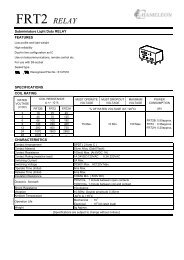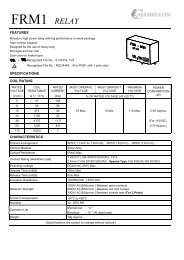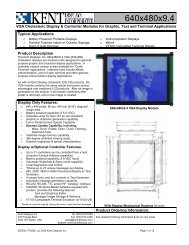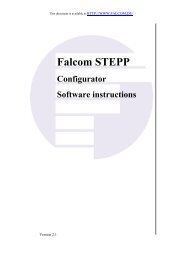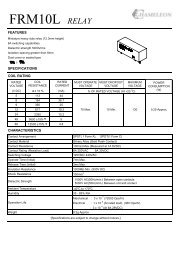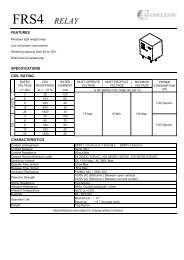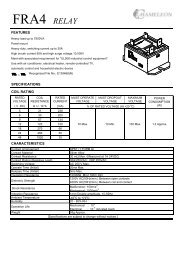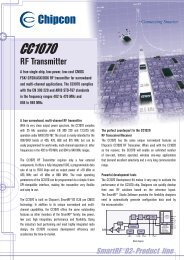XStream⢠Advanced Programming & Configuration
XStream⢠Advanced Programming & Configuration
XStream⢠Advanced Programming & Configuration
You also want an ePaper? Increase the reach of your titles
YUMPU automatically turns print PDFs into web optimized ePapers that Google loves.
XStream <strong>Advanced</strong> <strong>Programming</strong> & <strong>Configuration</strong> – <strong>Advanced</strong> Manual v4.2A<br />
HT (Time before Wake-up Initializer) Command<br />
If any radio modems within range are running in a “Cyclic Sleep” setting, a<br />
wake-up initializer must be used by the transmitter for the other modules to synchronize to the<br />
transmitter [see LH (“Wake-up Initializer Timer”) Command]. When a receiving module in Cyclic<br />
Sleep wakes, it must detect the wake-up initializer portion of the RF packet in order to<br />
synchronize to the transmitter and receive data. The value of HT Parameter tells the transmitter,<br />
“After a period of inactivity (no transmitting or receiving) lasting “HT” amount of time, send a<br />
long wake-up initializer”. HT Parameter should be set to match the inactivity timeout [specified<br />
by ST (Time before Sleep) Command] used by the receiver(s).<br />
From the receiver perspective, after “HT” time elapses and the inactivity timeout [ST (Time<br />
before Sleep) Command] is met, the receiver goes into cyclic sleep. Once it enters cyclic sleep,<br />
the only way for the module to be able to receive data from a transmitter is to first detect the<br />
wake-up initializer and synchronize to the transmitter. A long wake-up initializer must be used to<br />
ensure quick synchronization from all receivers in cyclic sleep. Thus, when time “HT” time elapses<br />
(matching the inactivity timeout); the transmitter then knows that it needs to send a long Wakeup<br />
Initializer for all receivers to be able to synchronize to its next transmission. Matching “HT” to<br />
the time specified by ST Command on the receiver(s) guarantees that all receivers will detect the<br />
next transmission.<br />
AT Command: HT<br />
Binary Command: 0x03 (3 decimal)<br />
Parameter Range: 0 - 0xFFFF (x 100 ms)<br />
# of bytes returned: 2<br />
Default Parameter Value: 0xFFFF (means no long Wake-up Initializer will be sent)<br />
Related Commands: LH (Wake-up Initializer Timer), SM (Sleep Mode), ST (Time before Sleep)<br />
ID (Modem VID) Command<br />
ID Command reads and reports the module’s VID. VID is a MaxStream-specific<br />
acronym that stands for “Vendor Identification Number”. This number is factory-set and allows<br />
modules with matching VIDs to communicate. Modules with non-matching VIDs will not receive<br />
unintended data transmission.<br />
AT Command: ID<br />
Binary Command: 0x27 (39 decimal)<br />
Parameter Range: 0 – 0xFFFF (Read-only)<br />
# of bytes returned: 2<br />
Minimum Firmware Version required: 4.27C<br />
© 2004 MaxStream, Inc., Confidential and Proprietary 31



